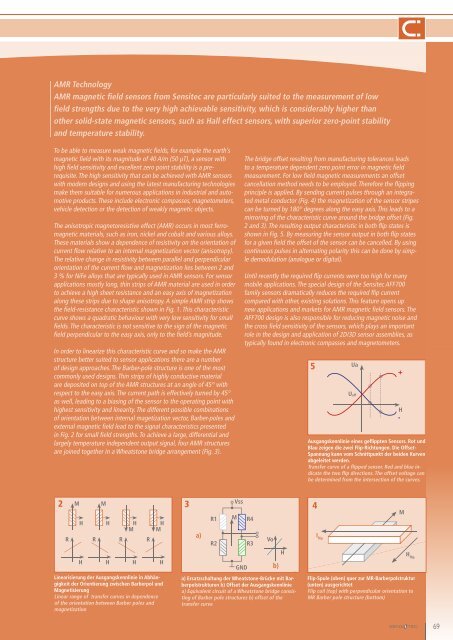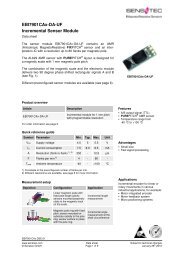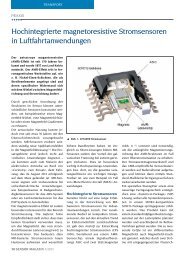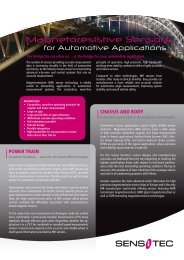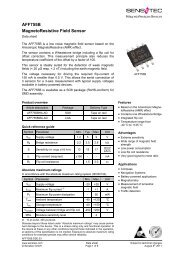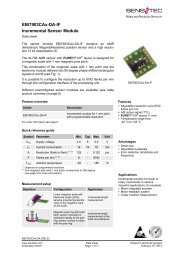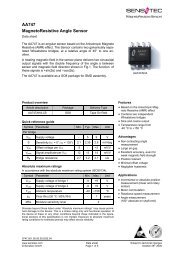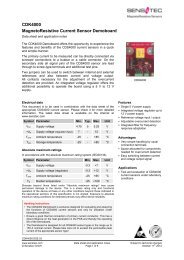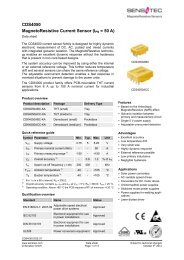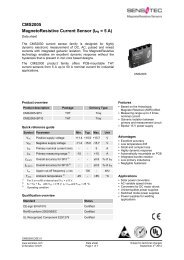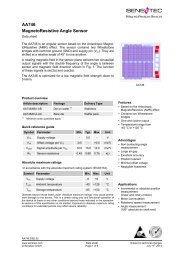WILLKOMMEN IM SENSOR KOSMOS WELCOME TO THE SENSOR COSMOS
WILLKOMMEN IM SENSOR KOSMOS WELCOME TO ... - Sensitec
WILLKOMMEN IM SENSOR KOSMOS WELCOME TO ... - Sensitec
- No tags were found...
Create successful ePaper yourself
Turn your PDF publications into a flip-book with our unique Google optimized e-Paper software.
AMR TechnologyAMR magnetic field sensors from Sensitec are particularly suited to the measurement of lowfield strengths due to the very high achievable sensitivity, which is considerably higher thanother solid-state magnetic sensors, such as Hall effect sensors, with superior zero-point stabilityand temperature stability.To be able to measure weak magnetic fields, for example the earth’smagnetic field with its magnitude of 40 A/m (50 µT), a sensor withhigh field sensitivity and excellent zero point stability is a prerequisite.The high sensitivity that can be achieved with AMR sensorswith modern designs and using the latest manufacturing technologiesmake them suitable for numerous applications in industrial and automotiveproducts. These include electronic compasses, magnetometers,vehicle detection or the detection of weakly magnetic objects.The anisotropic magnetoresistive effect (AMR) occurs in most ferromagneticmaterials, such as iron, nickel and cobalt and various alloys.These materials show a dependence of resistivity on the orientation ofcurrent flow relative to an internal magnetization vector (anisotropy).The relative change in resistivity between parallel and perpendicularorientation of the current flow and magnetization lies between 2 and3 % for NiFe alloys that are typically used in AMR sensors. For sensorapplications mostly long, thin strips of AMR material are used in orderto achieve a high sheet resistance and an easy axis of magnetizationalong these strips due to shape anisotropy. A simple AMR strip showsthe field-resistance characteristic shown in Fig. 1. This characteristiccurve shows a quadratic behaviour with very low sensitivity for smallfields. The characteristic is not sensitive to the sign of the magneticfield perpendicular to the easy axis, only to the field’s magnitude.In order to linearize this characteristic curve and so make the AMRstructure better suited to sensor applications there are a numberof design approaches. The Barber-pole structure is one of the mostcommonly used designs. Thin strips of highly conductive materialare deposited on top of the AMR structures at an angle of 45° withrespect to the easy axis. The current path is effectively turned by 45°as well, leading to a biasing of the sensor to the operating point withhighest sensitivity and linearity. The different possible combinationsof orientation between internal magetization vector, Barber-poles andexternal magnetic field lead to the signal characteristics presentedin Fig. 2 for small field strengths. To achieve a large, differential andlargely temperature independent output signal, four AMR structuresare joined together in a Wheatstone bridge arrangement (Fig. 3).The bridge offset resulting from manufacturing tolerances leadsto a temperature dependent zero point error in magnetic fieldmeasurement. For low field magnetic measurements an offsetcancellation method needs to be employed. Therefore the flippingprinciple is applied. By sending current pulses through an integratedmetal conductor (Fig. 4) the magnetization of the sensor stripescan be turned by 180° degrees along the easy axis. This leads to amirroring of the characteristic curve around the bridge offset (Fig.2 and 3). The resulting output characteristic in both flip states isshown in Fig. 5. By measuring the sensor output in both flip statesfor a given field the offset of the sensor can be cancelled. By usingcontinuous pulses in alternating polarity this can be done by simpledemodulation (analogue or digital).Until recently the required flip currents were too high for manymobile applications. The special design of the Sensitec AFF700family sensors dramatically reduces the required flip currentcompared with other, existing solutions. This feature opens upnew applications and markets for AMR magnetic field sensors. TheAFF700 design is also responsible for reducing magnetic noise andthe cross field sensitivity of the sensors, which plays an importantrole in the design and application of 2D/3D sensor assemblies, astypically found in electronic compasses and magnetometers.5UaU offH-Ausgangskennlinie eines geflippten Sensors. Rot undBlau zeigen die zwei Flip-Richtungen. Die Offset-Spannung kann vom Schnittpunkt der beiden Kurvenabgeleitet werden.Transfer curve of a flipped sensor. Red and blue indicatethe two flip directions. The offset voltage canbe determined from the intersection of the curves.+2MMH HM H M H R1 M R4a)R R R RVoR2 R3HH H H HGND b)Linearisierung der Ausgangskennlinie in Abhängigkeitder Orientierung zwischen Barberpol undMagnetisierungLinear range of transfer curves in dependenceof the orientation between Barber poles anda) Ersatzschaltung der Wheatstone-Brücke mit Barberpolstrukturenb) Offset der Ausgangskennliniea) Equivalent circuit of a Wheatstone bridge consistingof Barber pole structures b) offset of thetransfer curvemagnetization3Vss4I flipFlip-Spule (oben) quer zur MR-Barberpolstruktur(unten) ausgerichtetFlip coil (top) with perpendicular orientation toMR Barber pole structure (bottom)MH flip69


